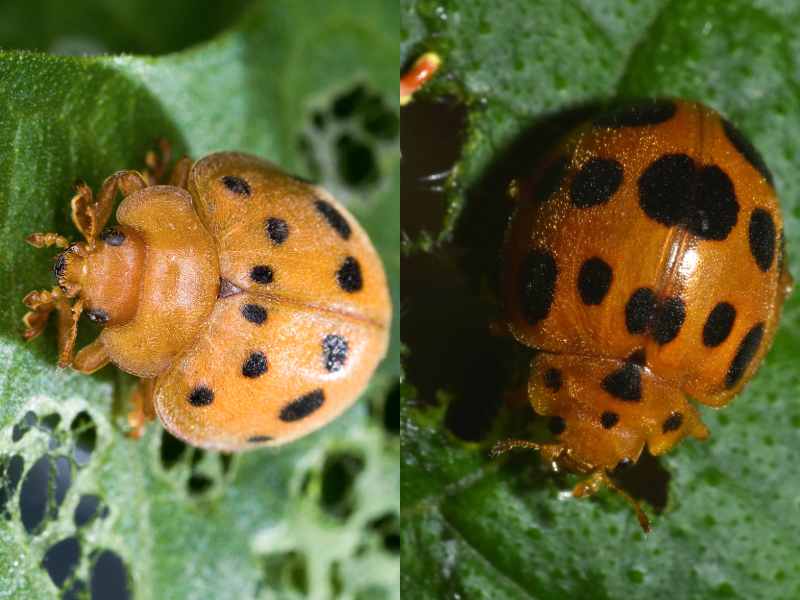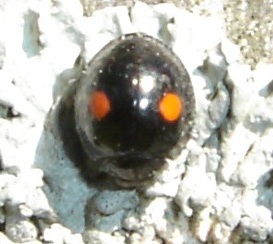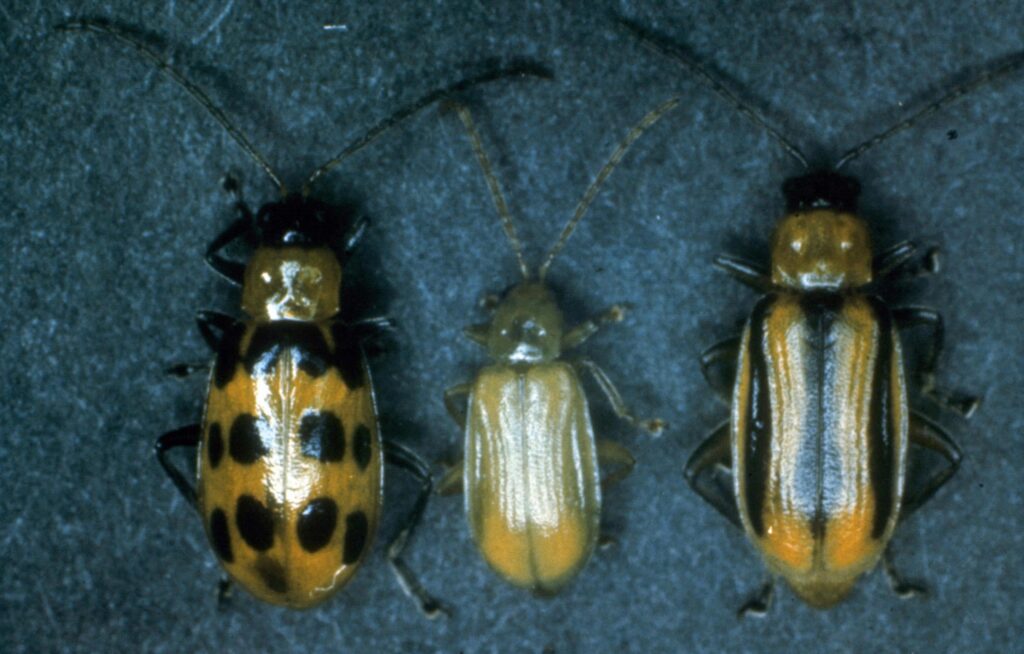What’s known as the ladybug in the United States is called the ladybird beetle in the UK or lady beetles elsewhere. Entomologists prefer those names because ladybugs are not “true” bugs, in the scientific sense.
Scientists also call them “beneficial” insects because they do something humans want them to. In this case, take care of pests in our gardens.
“Usually a lot of aphids or other kind of small, soft-bodied insects,” Texas A&M Agrilife Extension Service Specialist Wizzie Brown said.
» RELATED: Asian Ladybird Beetles Are Best Kept Outside…
While some beetles in the Coccinellidae family are pests – namely, Mexican bean beetles and squash beetles – most of the hundreds of species in North America are beneficial.

A Mexican bean beetle (left) and a southern squash lady beetle (Mangodreads, CC BY-SA 4.0 <https://creativecommons.org/licenses/by-sa/4.0>, via Wikimedia Commons).
Ladybug life cycle
Ladybugs have a complete lifecycle.
“The eggs are going to be typically laid in clusters near a food source, so a lot of times you’ll see a cluster of them near aphids and they look like little tiny footballs kind of sitting up on end. And they’re kind of a yellowish-orangish color,” Brown said.
When they grow into their immature larval stage, they’ll already be predators.
“They are mainly going to feed on aphids, but they can also feed on scale insects, mealybugs, whiteflies, mites sometimes and maybe like small caterpillars or something,” Brown said.
Ladybug larvae look quite a bit different from the adults.
 “I’m going to say an alligator body shape. They are a grayish blackish color with kind of yellowish orangish markings on them,” Brown said.
“I’m going to say an alligator body shape. They are a grayish blackish color with kind of yellowish orangish markings on them,” Brown said.
Some ladybug larvae in Texas look a lot like one thing they eat – mealybugs.
“And those are actually called mealy bug destroyers,” Brown said. “So they look very similar to mealybugs. They’re kind of white, and they’ve got these fluffy kind of things that come off of their body. They’re oval, they’re wingless.”
Brown said you can tell them apart by watching them move.
“Mealybugs are really slow,” Brown said. “Mealybugs tend to cluster together. Whereas the mealybug destroyers, while they look like mealybugs, they don’t hang out with other mealybug destroyers because predators don’t like hanging out with other predators. They might get eaten, and the mealybug destroyers are quick. They kind of move around very fast because a predator needs to be fast to catch whatever they’re going to capture.”
Identifying adult ladybugs
Like their immatures, adult ladybugs feed on aphids, but they can also feed on nectar, pollen and honeydew. And if you have an image in your head of a ladybug – you may need to expand it a bit.
“When I say the word ‘ladybug,’ everybody automatically thinks of a roundish oval insect that’s red in color with black spots. That’s just the automatic picture that you get,” Brown said.
But, she says, not all ladybugs look like that.

By Parihav at the English-language Wikipedia, CC BY-SA 3.0, https://commons.wikimedia.org/w/index.php?curid=24852102
“We have one in Texas that is black and it has two red spots. It’s called a twice stabbed ladybird beetle, which is fantastic because, you know, it was stabbed twice,” Brown said.
Others don’t have any spots.
“There’s a little teeny tiny one that most people don’t even realize is a ladybird beetle that is like a shiny metallic bluish black color,” Brown said. “But it’s like the head of a pin. It’s tiny, but again, still beneficial. Absolutely fantastic.”
Brown said one insect that gets confused for ladybugs all the time is the cucumber beetle.
“They’re kind of an oval to teardrop shaped beetle that is anywhere from yellow to a yellowish green. And they have black spots on their back,” Brown said.

The cucumber beetle (far left) often gets mistaken for a ladybug.
She says people see a beetle with black spots and they think it’s a ladybug…
“But that particular beetle actually feeds on garden crops,” Brown said. “So if you see that one, it’s not a good one to have around.”
Keeping them in your garden
Yes, you can purchase ladybugs to release but Brown said that’s not a great idea unless you take a few steps first.
“If you just release them into the backyard, they typically fly away and they’re controlling bugs somewhere, but it’s just probably not in your yard, unfortunately,” Brown said. “It’s a good idea to get maybe a pop-up greenhouse thing to stick over the plant, release those ladybugs in there, give them enough time to lay eggs on that plant, and then you could take the greenhouse off, and then they can go and lay eggs wherever they want.”
Even better may be to encourage natural populations of ladybugs to come in your yard. Brown said you do that by not being so hung up about having aphids on your plants.
“Yes, they can cause damage, but you’re going to need populations of aphids to bring those ladybugs in,” Brown said. “And if you kind of let things go for a while and just kind of keep an eye on the population, a lot of times you will see that those aphids are then taken care of by not only ladybug larvae, but there are also syrphid fly larvae, lacewing larvae.
We have little parasitic wasps that will attack them, so there’s a lot of stuff that’s going to naturally control those populations. So if you kind of keep off of the pesticides and let nature take its course and watch what happens, things can balance out on its own.”
When ladybugs become pests
Ladybugs are typically active spring through fall. In the wintertime, when it gets colder, they will move into sheltered locations.
“Typically they’re going to go outside in kind of a crack or crevice or they may crawl under the siding of a house or something,” Brown said.
But if there are sealing problems in your house, ladybugs could also move in with you – and becomes a pest.
“So if ladybugs are in the garden eating aphids, fantastic. When they move in, you know, I would say vacuum them up and then try to figure out where they’re coming in from and seal that off,” Brown said.
Do you have a bug question for Wizzie Brown? Drop us a line, and we’ll pass it along.
If you found the reporting above valuable, please consider making a donation to support it here. Your gift helps pay for everything you find on texasstandard.org and KUT.org. Thanks for donating today.
















